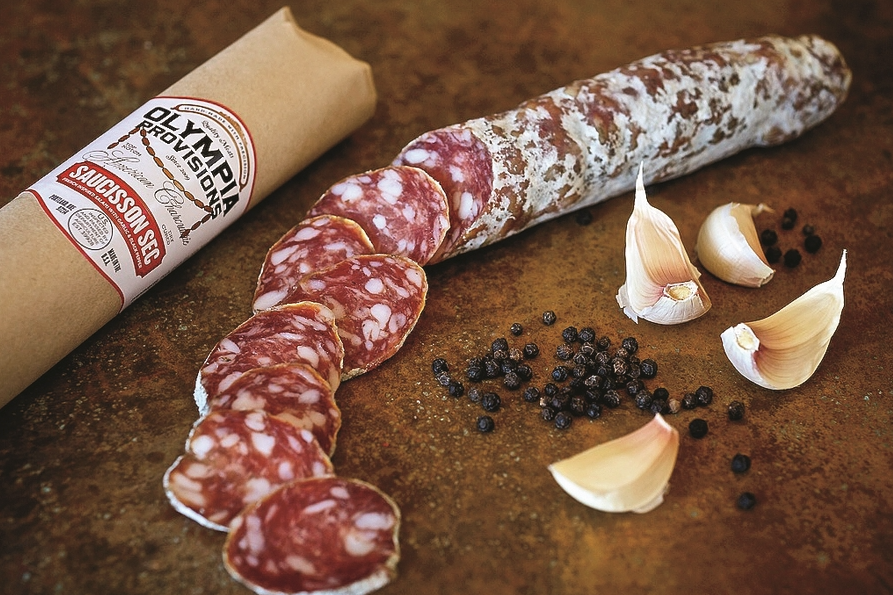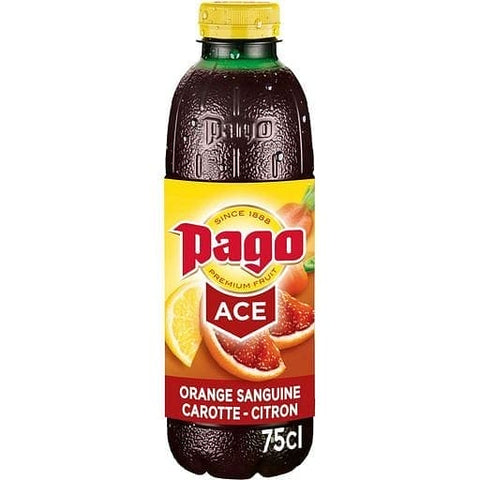Saucisson sec is a world-renowned French cured pork sausage. Its defining characteristic is the use of only the finest cuts of pork and an unparalleled level of craftsmanship in production.
Saucisson sec is a traditional French charcuterie product, meaning it's made with pork and usually flavored with pepper, wine, and garlic. The meat is cured and air-dried for weeks, producing a hard sausage that's served in thin slices or dice.
In France, Saucisson sec is often made with the fat from pigs bred in the mountains because they live on a diet rich in the acorn, which produces flavorful fat. It's also important that the pigs be lean and muscular so that the Sausage has enough strength to dry without cracking or falling apart.
Our Saucisson sec products are made using time-honored techniques, using only the highest quality French pork.
Origin of Saucisson Sec
Saucisson sec is a type of Cured Sausage. It's made of finely-ground pork, salt, and various spices like garlic, peppercorns, and wine. In France, Saucisson sec is commonly found in the deli sections of supermarkets. This meat product is often eaten cold, on its own, or as part of a charcuterie plate.
Saucisson sec is a dry-cured sausage from France. The name means "dry sausage" in French. It's made with lean cuts of pork seasoned with salt and sometimes herbs, garlic, and spices like peppercorns or wine. Sometimes these are stuffed into natural casings, but now many manufacturers use collagen casings to make them more shelf-stable and easier to eat without cooking.
- Saucisson sec has been made for hundreds of years to preserve meat before standard refrigeration. Before cooking, the meat would be cured in salt or dried using natural methods like air drying or smoking to keep it for more extended periods without spoiling. Nowadays, we eat this type of sausage cold rather than hot because we have refrigeration available, so there's no need to cure it anymore except for flavor purposes!
How do you eat Saucisson Sec?
A whole salami is meant to be sliced and eaten — the dry-cured kind (Saucisson sec) most often, but some of the soft, fresh ones as well.
How do you eat dry-cured Saucisson? The French do it two ways: with a knife and fork or by slicing it thinly with a particular machine with a long, skinny rod you push through the meat to slice off paper-thin slices. You can also use a food processor or meat slicer.
The most traditional way to eat dried Sausage is to cut off a small chunk and slice it into thin slices, and then eat those chunks plain or on a piece of bread.
Saucisson Sec is ready to eat
Like salami and prosciutto, most cured sausages are safe to eat without cooking. Sausages meant to be eaten cooked include raw ground sausage, Bratwurst, bologna, hot dogs, Kielbasa, and liver sausage.
Saucisson sec can be eaten raw because it is a dry-cured sausage.
There are three different types of Sausage. For the purpose here, I am going to categorize it as:
Ready to Eat: Can be eaten as is, and no further preparation is required. Example: Hot Dogs, Polish Sausage, Chorizo Sausage, Pepperoni, Genoa Salami, etc.
Cooked: Must be cooked before consumption. Example: Italian Sausage in the casing, Bratwurst in the case, Kielbasa in the container, etc.
Raw Fermented: Must be cooked before consumption and is fermented. Example: Dry Salami (Sopressata), Spanish Chorizo, Hungarian Salami (Szegedi), etc.
There are other classifications, but for your question, this should help. Many raw fermented sausages can be sliced and consumed without cooking first, but this is a personal preference, and only you can decide if it's safe to do so or not.

Difference between Salami and Saucisson
- Salami is the generic name for a sausage made by curing or drying meat. Saucisson is a type of salami made from pork.
- The big difference between fresh Sausage and salami is that salami has been cured, whereas fresh Sausage has not. Salami can be dry-cured, which means it is rubbed with salt and spices and then air-dried for weeks or months. This type of curing does not require any refrigeration. It can also be wet cured, which means it is immersed in a brine solution; wet-cured salamis must be refrigerated.
- Salami is usually flavored with garlic, peppercorns, and other seasonings. There are many types of salami; some are hard, while others are soft or spreadable.
- Saucisson (also called Saucisson sec) is French salami usually made from pork (although beef can be used). It is drier and firmer than other salamis because it contains less fat; it comes in long links rather than in chunks like different types of salami. It may be flavored with red wine and various herbs and spices; some varieties are smoked as well as cured.
How long does Saucisson Sec last?
Meats like saucisson sec are cured meats. Cured meats are saltier than their fresh counterparts and will last longer. This is due to the high salt content, which inhibits bacterial growth in the meat and helps preserve it. Fresh meats are more prone to spoilage and should be consumed within a couple of days.
- Saucisson sec can last for months if stored correctly in a cool, dry place like a cellar or garage. They can even be kept in the fridge but will lose some of their flavors as a result since there's less air circulation.
- If you want to extend their shelf life even further, try wrapping them tightly in plastic wrap before putting them into an airtight container with some dry ice; this should keep for several years without any loss of flavor!
Any need to cook the dry-cured Sausage
"Dry-cured" describes the process by which raw meat is rubbed with a salt mixture and hung to age. It's not just cured in an unsmoked form, as a ham would be.
The question, then, is whether you need to cook it before you eat it, and the answer is no—it's already cooked.
Think about it this way:
Ham starts as raw meat like Sausage. But you never cook your ham before eating it. You can, but that's not how most people eat it (and not how most restaurants serve it). When you buy a ham at the supermarket or order it at a restaurant, it's been processed and is safe to eat.
Dry-cured Sausage is no different. It's hanging in a curing room somewhere for at least six weeks or more (or up to a year or more), during which time all sorts of good stuff happens: The salt draws out moisture from the meat while enzymes break down proteins and fat, creating new flavors and tenderizing the meat. And—just like with a ham—the meat cooks from the inside out due to the amount of salt in its environment.
Taste of Saucisson Sec
The taste of saucisson sec depends on the variety. Some are spicy; others are mild; some are packed with herbs, and others have minimal seasoning; they can be smoked or unsmoked. The most common variety I grew up calling "saucisson à l'ail" literally means "garlic sausage." It's a classic French sausage flavored with garlic and just a little bit of pepper and salt, made from pork loin — so it's leaner than other charcuterie. Saucisson sec is the classic "sausage" of charcuterie, and it comes in many different shapes and sizes, with different flavors and textures.
It's made by salting, seasoning, and stuffing ground meat into a casing. When the Sausage is done curing, it's hung to dry — hence the name "sec" or "dry”. Many saucissons are made with pork — or sometimes a mix of pork and beef — but there are exceptions like a duck, wild boar, and even horse.
- In terms of taste, it can be hard to generalize, though you will find a few similarities between all saucisson. These are dry sausages, so they don't have much moisture. The spices used in the seasonings — sometimes pepper, garlic, or herbs — vary from one Sausage to another.
What do you serve with Saucisson?
Saucisson is a delicious sausage, but still just a sausage. That means that you treat it like any other sausage -- in other words, you serve it with whatever else you might serve Sausage with.
If you're cooking saucisson from scratch at home, then you can do anything from roasting it to putting it into a stew. If you're buying ready-made saucisson from the shop, there are two main ways of serving it: cold or hot.
- Hot saucisson is either cooked (like Bratwurst) or grilled (Sausage on a stick). You can serve it with the traditional French accompaniments of fries or mashed potatoes and salad, or eat it on its own. It goes well with strong cheeses like Comte or Beaufort.
- Cold saucisson is served as part of a charcuterie platter, giving you plenty of opportunities to match flavors. The classic French accompaniments are raw vegetables like cornichons, radishes, baguettes, and cheese. You can also try adding figs or pears to cut through the fat and add some sweetness.
Eating the Saucisson Sec
Saucisson sec should be sliced as thin as possible since it can be somewhat chewy if it is too thick.
To serve, slice thinly and arrange on a plate with cheese and bread (or other food you like). Accept the rind (the skin). It's edible and adds flavor to the first slices of saucisson you cut from a new piece.
Can you eat the skin of saucisson sec?
Like any other dried sausage, you can eat the skin. The skin is made from the same meat and fat as the Sausage rest, and it is wrapped around the meat and fat, stuffed into a casing. The meat and fat inside the Sausage are never cured. They are fresh meat, cured in salt, seasonings, and sodium nitrate/nitrite. This process creates a safe environment for consuming it without cooking it. The natural casing (pork intestine) is not edible either because it's very chewy and rubbery when dry-cured. So when you eat this type of sausages, you always eat them sans the casing!
The reason why traditionally dry-cured saucisson sec has a casing that is not to be eaten is that it's used as a container. If you would try to cure a sausage without any case, then you'd end up with a piece of cured meat that may have no shape at all, or worse: it would lose moisture during the curing process and turn out to be quite challenging (like jerky). It also serves as protection from oxidation by air exposure during curing. If you have eaten chorizo, then you know what I mean!
Types of Dry-cured Sausage
The main types are:
Dry-cured ham is made from a pig's hind leg, and then cured. This requires immersing the meat in brine and covering it with salt and sugar. For some hams, the curing process is complete at this stage. For others, the ham is then air-dried for several months, during which time it develops its unique taste and texture.
These include chorizo, salami, and pepperoni. They are made with coarsely chopped pork meat and fat and seasoned with garlic, paprika, and other spices. They are then stuffed into natural casings and allowed to ferment (essential to ensure they do not spoil) before being air-dried for several weeks to develop their flavor.
The sausages usually are cut into slices or chunks before being eaten on their own or added to dishes like pasta sauces, pizza, or salads. Some sausages have a strong flavor (like chorizo), while others have a more delicate taste (salami).
Bacon needs to be cooked before eating, so it is not classed as a ready-to-eat food like dry-cured sausages.
We may say that Saucisson sec represents an ancient food preservation method that has been adapted for modern times. Our ancestors had to preserve meat for long periods without refrigeration or freezing by salting it or drying it until all the moisture was gone. It's still used today because people enjoy this drying process's more robust flavors.




